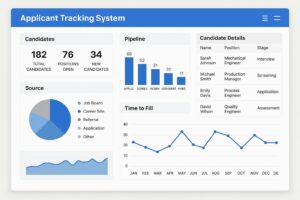Sourcing Manufacturing Engineering Talent
Key Takeaways
- A clear plan helps you find and hire skilled engineers faster.
- Simple, step-by-step techniques work well for sourcing engineers.
- Current data and modern tools improve manufacturing engineering talent acquisition techniques.
- A strong employer brand and engaging communication create a solid talent pool.
Sourcing manufacturing engineering talent is key to building a strong team. Companies need skilled engineers who can solve problems and drive growth. This guide explains clear and simple methods for sourcing engineers.
Understanding the Need for Sourcing Engineers
Companies face a competitive market when hiring engineers. Many firms vie for the same skills. A well-planned strategy helps you stand out by showing candidates what your company values. Research indicates that clear talent acquisition strategies can reduce hiring time by up to 30%. This saves time, cuts costs, and improves the quality of hires. Skilled engineers are hard to find without clear methods. This guide covers simple techniques that help build a reliable talent pool.
Defining manufacturing engineering Talent Acquisition Techniques
Effective techniques include:
- Writing clear, precise job ads
- Using current data to guide your search
- Leveraging social media and professional networks
- Building a strong employer brand
- Engaging both active and passive candidates
Each technique helps you find candidates who not only match your skills list but also fit your company culture.
Conducting Market Research
Start with market research. Look at job boards, industry reports, and competitor sites to learn which skills are in demand. Current data shows many companies seek engineers with expertise in renewable energy, cloud computing, or data analysis. Use these insights to write job ads that list the necessary skills. Up-to-date salary data also helps you set competitive pay ranges. Research reveals that competitive offers can attract up to 25% more qualified candidates.
Writing Clear Job Ads
Clear job ads are essential for sourcing engineers. Write ads in plain language that list the main tasks and required skills. Break your ad into bullet points so candidates can quickly assess if they fit the role. For instance, include:
- A brief role description
- Daily tasks and key responsibilities
- Required technical skills (e.g., SolidWorks, SolidEdge, PLCs, HMI, SCADA, 3D CAD, FMEA, APQP, SPC, Lean, Six Sigma, Continuous Improvement etc.)
- Experience level and team information
This format helps your ad rank better on search engines and makes it easy for candidates to understand.
Building a Strong Employer Brand
A strong employer brand attracts skilled engineers. Your website and social media should clearly state your mission and values. Use real images and short videos that show your team at work. For example, sharing a video of engineers collaborating on a sustainable project can build trust. Studies show that companies with clear employer brands receive 40% more applications. A positive image makes candidates more likely to consider your roles.
Leveraging Social Media and Professional Networks
Social media platforms like LinkedIn and Twitter offer a wide reach. Post clear and engaging job ads with relevant hashtags such as “sourcing engineers” and “manufacturing engineering talent acquisition techniques.” Networking on professional sites allows you to send brief, personal messages to potential candidates. A message like, “I noticed your work in renewable energy. We have a role that may suit your skills,” can spark interest.
Engaging with Passive Candidates
Many skilled engineers are not actively job hunting. Build a strong online presence to attract these passive candidates. Share company updates, project stories, and benefits like flexible working hours. Clear, engaging content can prompt passive candidates to consider a change. This approach widens your talent pool.
Using Modern Tools
Modern tools make the hiring process faster. Many companies use Applicant Tracking Systems (ATS) to store and organise CVs. An ATS can post job ads on multiple platforms at once, saving time. Online tests and coding challenges quickly assess a candidate’s skills. Video interviews allow you to meet candidates remotely. These tools simplify the process and help maintain clear communication.
Building and Maintaining a Candidate Pool
A candidate pool is a list of potential hires. Use your ATS or a simple database to store candidates’ details. Update the pool regularly. When a new role opens, contact candidates from your pool. This proactive approach saves time and builds long-term relationships with skilled engineers.
Creating a Clear Recruitment Process
Divide your recruitment process into clear steps:
- Job Ad Posting: Write and post a clear ad.
- CV Screening: Use a checklist to review each CV.
- Initial Contact: Send a brief email to confirm interest.
- Interviews: Conduct structured interviews with standard questions.
- Skills Assessments: Use online tests to evaluate technical skills.
- Job Offer: Send a clear offer letter stating salary, benefits, and start date.
Each step should have clear instructions and deadlines. This transparency benefits both your team and the candidates.
Measuring the Success of Your Sourcing Strategy
Measure your success by tracking key metrics:
- Number of applications
- Candidates passing each stage
- Time to fill a role
- Quality of hires
Use simple charts to display these metrics. If a stage takes too long, adjust your process accordingly. Data-driven insights help you refine your approach and reduce delays.
Engaging with manufacturing engineering Communities
Engage with online communities where engineers gather. Join forums, social media groups, and local meet-ups. Share useful content like industry news, project updates, or tips on new technologies. Clear, helpful posts build trust and make engineers more aware of your company. This engagement encourages skilled professionals to consider your job offers.
Collaborating with Educational Institutions
Partner with universities and technical colleges to access fresh talent. Many manufacturing engineering students seek internships or entry-level roles. Build relationships by offering guest lectures or sponsoring events. These partnerships introduce your company to new talent and enhance your image as a forward-thinking employer.
Using Employee Referrals
Employee referrals often yield high-quality candidates. Encourage your team to refer skilled engineers by offering clear incentives. Keep the referral process simple by asking for a short email with candidate details. Employee referrals build a network of trusted candidates and often lead to faster hires.
Creating a Positive Candidate Experience
A smooth candidate experience is essential. Use clear communication at every stage. Send brief emails explaining the next steps, such as interview schedules and test instructions. Fast responses and regular updates show respect for the candidate’s time. A positive experience builds a good reputation and encourages word-of-mouth referrals.
Training Your Recruitment Team
Ensure your recruitment team understands every step of the process. Hold regular training sessions on new tools and simple techniques. Use plain examples to show what works best. A well-trained team can source engineers more effectively and keep the process consistent.
Using Data-Driven Decisions
Track your recruitment process with simple charts. Look at the number of applications, screening times, and hiring speed. If a stage slows down, gather feedback and make changes. Data-driven decisions can reduce hiring time by up to 20%. Regularly review your metrics to keep the process efficient and fair.
Keeping Up with Industry Trends
Stay updated with the latest trends in manufacturing engineering. Read industry news, reports, and surveys to learn about new skills and tools. If a new programming language or technology becomes popular, update your job ads accordingly. Keeping current shows candidates that your company is modern and well-informed.
Maintaining Continuous Improvement
Your recruitment process should be dynamic. Set a schedule to review and update your methods every six months. Ask your team for feedback after each hiring cycle. Small, regular adjustments help your process remain effective. A continuous improvement mindset ensures that your manufacturing engineering talent acquisition techniques stay strong.
FAQs
Q: What are the most effective ways to source manufacturing engineering talent?
A: The best methods include market research, clear job ads, leveraging LinkedIn and social media, engaging passive candidates, and using tools like ATS and online tests.
Q: How do I attract passive manufacturing engineers?
A: Build a strong employer brand, share engaging company updates, and send personalised outreach messages that highlight interesting projects, flexible work, or career growth opportunities.
Q: Why is employer branding important when sourcing engineers?
A: A clear, authentic employer brand builds trust and attracts more qualified candidates. Companies with strong branding receive up to 40% more applications and hire faster.
Q: How can I build and maintain a manufacturing engineering talent pool?
A: Use an ATS or spreadsheet to track candidate details, keep the list updated, and re-engage previous applicants when roles open. Regular contact keeps your pipeline warm and efficient.
Summary and Final Thoughts
Sourcing manufacturing engineering talent requires a clear plan and simple steps. The key methods include:
- Conducting market research to understand demand
- Writing clear job ads with key skills and tasks
- Building a strong employer brand
- Leveraging social media and professional networks
- Engaging both active and passive candidates
- Using modern tools like ATS, online tests, and video interviews
- Maintaining a candidate pool and tracking progress with data
- Staying current with industry trends
- Training your recruitment team and encouraging employee referrals
By following these steps, you can use effective manufacturing engineering talent acquisition techniques to source engineers faster and with better results. A clear, simple process saves time, reduces hiring costs, and improves the quality of hires. This approach helps your company build a strong team that drives growth and supports success.
Implement these strategies one step at a time. Measure your progress, adjust your process, and maintain clear communication with candidates. Continuous improvement is key. With a clear plan and simple steps, your company can successfully source manufacturing engineering talent and stay competitive in today’s busy market.












